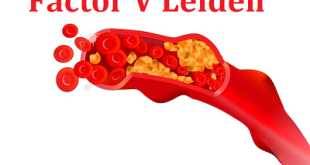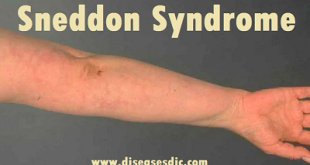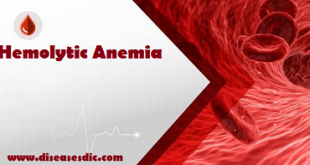Definition
Porphyria are a group of rare inherited blood disorders. People with these disorders do not make heme, a component of hemoglobin (protein in red blood cells that carries oxygen) properly. Heme is made of porphyrin (a naturally-occurring organic compound in the body) bound to iron. Heme helps red blood cells (RBCs) carry oxygen and also gives RBCs their color. It is also found in myoglobin, a protein in the heart and skeletal muscles.

Porphyria patients lack the enzymes necessary to complete the process that is needed to produce heme. This results in the accumulation of porphyrin in tissues and blood, which causes various symptoms. Depending on which enzyme is missing in the body, the symptoms vary. Stomach pain, rash or blister due to light sensitivity, and muscle problems are the most common symptoms.
Porphyrias are mostly inherited, but rarely they are acquired. All types of porphyrias are inherited as autosomal dominant disorder except congenital erythropoietic porphyria (CEP), which is autosomal recessive. Some result in severe and acute symptoms, while some are chronic and cause less severe symptoms.
History
Porphyrias have been detected in all races and in multiple ethnic groups on every continent, including Africans, Asians, Aboriginal Australians, Caucasians, Peruvians, Mexicans, Native Americans, and Sami. There are high incidence reports of acute intermittent porphyria (AIP) in areas of India and Scandinavia. More than 200 genetic variants of AIP are known, some of which are specific to families, although some strains have proven to be repeated mutations.
The underlying mechanism was first described by Felix Hoppe-Seyler in 1871, and acute porphyrias were described by the Dutch physician Barend Stokvis in 1889. The links between porphyrias and mental illness have been noted for decades. In the early 1950s, patients with porphyrias (occasionally referred to as “porphyric hemophilia”) and severe symptoms of depression or catatonia were treated with electroshock therapy.
Prevalence of Porphyria
The combined prevalence of the acute porphyria is approximately 5 cases per 100,000 persons. Porphyria cutanea tarda is the most common porphyria, with a prevalence of 1 in 10,000. The most common acute porphyria, acute intermittent porphyria, has a prevalence of approximately 1 in 20,000, and the prevalence of the most common erythropoietic porphyria, erythropoietic protoporphyria, is estimated at 1 in 50,000 to 75,000. Congenital erythropoietic porphyria is extremely rare, with an estimated prevalence of 1 in 1,000,000 or less. Fewer than 200 cases have been reported in the literature.
A specialist center network (European Porphyria Network [EPnet]) estimated the risk of recurrent attacks at 4% of porphyria patients in Europe. The incidence was around 0.13 case per million per year in most European countries, except Sweden, where it was 0.51 case per million per year.
Types of Porphyria
There are several different types which are classified into two categories: Hepatic and erythropoietic. Hepatic forms of the disorder are caused by problems in the liver and are associated with symptoms such as abdominal pain and problems with the central nervous system. Erythropoietic forms are caused by problems in RBCs.
Hepatic porphyria are of five types:
- Acute intermittent (AIP)
- Hereditary coproporphyria (HCP)
- Variegate porphyria
- Aminolevulinic acid dehydratase deficiency (AVADDP)
- Porphyria cutanea tarda (PCT)
PCT is the most common type of porphyria. It is associated with extreme sensitivity to sunlight.
Erythropoietic porphyria is associated with light sensitivity. There are two types:
- Muroporphyria
- Protoporphyria
Risk factors
In addition to genetic risks, environmental factors may trigger the development of signs and symptoms in porphyria. When exposed to the trigger, your body’s demand for heme production increases. This overwhelms the deficient enzyme, setting in motion a process that causes a buildup of porphyrins.
Examples of triggers include:
- Exposure to sunlight
- Certain medications, including hormone drugs
- Recreational drugs
- Dieting or fasting
- Smoking
- Physical stress, such as infections or other illnesses
- Emotional stress
- Alcohol use
- Menstrual hormones- acute porphyria attacks are rare before puberty and after menopause in women
Causes
The most types of porphyria are autosomal dominant, meaning that a person only inherits the abnormal gene from one parent. However, certain factors may trigger symptoms, known as “attacks.” Factors include:
- Drugs
- Infection
- Alcohol use
- Certain hormones, such as estrogen
- Sunlight
Symptoms
Symptoms depend upon the type of porphyria. Severe abdominal pain is present in all types, as well as urine that is reddish-brown in color. This is caused by the build-up of porphyrins, and typically occurs after an attack.
Symptoms associated with hepatic disease include:
- Limb pain
- Neuropathy
- Hypertension
- Tachycardia (fast heartbeat)
- Electrolyte imbalance
Symptoms associated with erythropoietic disease include:
- Extreme skin sensitivity to light
- Anemia (when the body does not produce enough new RBCs)
- Changes in skin pigmentation
- Erratic behavior related to sun exposure
Diagnosis and test
- Blood, urine, and stool tests are performed to diagnose porphyria. The best time to be tested is during an outbreak of symptoms or around the time of them.
- Sometimes multiple tests will be required before the diagnosis of a particular type of porphyria is possible. Because porphyria often runs in families, other family members can be tested and counseled after a positive diagnosis.
Treatment and medications
There is no cure and the treatment focuses on managing symptoms. Most cases are treated with medication.
Treatments for hepatic disease include:
- Beta blockers (Atenolol) to manage blood pressure
- High carbohydrate diet to aid recovery
- Opioids for pain management
- Hematin to shorten attacks
Treatments for erythropoietic disease include:
- Iron supplements for anemia
- Blood transfusions
- Bone marrow transplant
Prevention of Porphyria
It cannot be prevented. However, symptoms can be reduced by avoiding or eliminating triggers.
Factors that should be eliminated include:
- recreational drugs
- mental stress
- excessive drinking
- certain antibiotics
Preventing erythropoietic symptoms focuses on reducing light exposure by:
- staying out of bright sunlight
- wearing long sleeves, hats, and other protective clothing while outside
- asking for protection during surgery – in rare cases phototoxic injury can occur. This happens when light perforates the organs and leads to infection.
 Diseases Treatments Dictionary This is complete solution to read all diseases treatments Which covers Prevention, Causes, Symptoms, Medical Terms, Drugs, Prescription, Natural Remedies with cures and Treatments. Most of the common diseases were listed in names, split with categories.
Diseases Treatments Dictionary This is complete solution to read all diseases treatments Which covers Prevention, Causes, Symptoms, Medical Terms, Drugs, Prescription, Natural Remedies with cures and Treatments. Most of the common diseases were listed in names, split with categories.








I have porphyria according to what is explained above.i normally get sleepless nights, severe backache, severe abdominal pain,mental confusion less man power.give me that immediate therapy for the symptoms that I have listed above.thanks